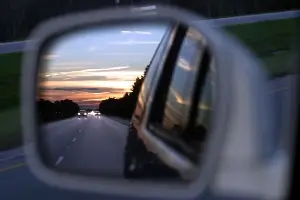Blind spot car accidents are dangerous, taking drivers completely by surprise. The fact is, even when drivers check their mirrors carefully, they can still miss seeing you in their blind spot zone. So, who may be liable for these crashes?

At Andy Citrin Injury Attorneys, we have managed a lot of car crash cases, including victims injured in blind spot collisions. Our knowledgeable car accident attorneys in Mobile are prepared to learn more about the crash that injured you, answer your questions, and help you understand what legal options you may have.
When we say, “Andy Wins, or We Don’t Get a Dime,” we mean business. If we take your case, we believe we can win it, and we are prepared to work diligently to protect your rights and secure the maximum possible compensation on your behalf.
Injured by a Negligent Driver in Mobile? We want to help! Call Andy Citrin Injury Attorneys today for a FREE consultation: 251-888-8888.
What Is a Blind Spot Crash and How Do They Happen?
A blind spot car crash occurs when a driver does not see another vehicle traveling next to them in an adjacent lane. If they attempt to move into that adjacent lane without first properly checking for traffic, it can lead to a crash.
These types of crashes are very common, because every vehicle has blind spot zones where the driver cannot see other cars, motorcycles, or pedestrians just by looking in their rear-view or side mirrors. The size and location of these zones varies depending on the vehicle size and type, mirror positioning, and seat adjustment.
Where Are the Blind Spot Zones on a Car, Minivan, SUV, or Smaller Pickup Truck?
It is every driver’s responsibility to know where their blind spots are, as well as the general location of blind spots on other vehicles. Lane assist audio and visual alerts are great when they work – and when the driver isn’t tuning them out after getting too used to the sound.
No one should be fully relying on technology to keep them safe on the road. These driver assistance safety features are helpful but cannot be considered foolproof.
Drivers still have a responsibility to do the “check-double-check” routine to avoid hitting another vehicle in their blind spot zone. All drivers can help avoid blind spot crashes by avoiding traveling in those zones and by recognizing when they might be invisible to other motorists.
Passenger Car Blind Spots
The most dangerous blind spots on a passenger vehicle are near the back corners. Below are some common blind spot areas on a passenger vehicle.
- Left Side: The blind spot on the driver’s side starts a few feet behind the door and stretches about 15 feet back at an angle. It is as wide as one lane and can easily hide a small car, motorcycle, or a person walking.
- Right Side: The passenger-side blind spot is bigger and harder to see because it’s farther from the driver. It may conceal even large vehicles, especially those with sports cars or thick roof pillar designs.
- Rear Blind Spot: There’s a blind spot right behind your car that covers the area just beyond the bumper. This makes it easy to miss people, bikes, or other cars when backing up.
Minivan Blind Zones
Minivans have bigger blind spots than regular cars because they are taller, longer, and have smaller rear windows. Although drivers tend to sit higher, they cannot see more in the front. It is harder to see around the sides and back, especially behind the van. In the back of the van, there is a large blind spot area that also blocks parts of nearby lanes.
These rear blind spot areas are risky for children who may be playing while a van is backing out of a driveway, since they are often completely hidden from view. Backup cameras help drivers to see better, but it is a good idea to check for nearby children before getting into the vehicle to back up. The right side is also tough to see from the driver’s seat. Sliding doors may block the view even more, sometimes hiding multiple cars during a lane change or when attempting to exit a roadway.
SUV Blind Spot Zones
SUVs have some of the biggest blind spots because they combine the visibility issues of both cars and trucks. Smaller SUVs have blind spots similar to those of minivans, while larger ones can have blind zones as extensive as those of pickup trucks.
The higher seat in an SUV can create a blind spot in front of the bumper, making it hard to see small cars, people, or bikes, especially in parking lots or school zones. On the sides, full-size SUVs can have blind spots that cover up two lanes, which worsens in models with a third row of seats.
Smaller Pickup Trucks’ Blind Spots
The blind spots of pickup trucks vary considerably due to the differences in height, length of the truck beds, and upright seating positions. The bed creates a big blind spot behind the truck, and it is wide enough to hide people, bikes, or even other cars. Since many pickups do not have a clear view out the back window, drivers often rely completely on their mirrors and backup cameras – if they have them.
The bigger the truck, the harder it is to see around it – or in front of it. Larger pickup trucks have a very poor view of smaller vehicles, motorcycles, and pedestrians in front of them. Since larger pickup trucks are also heavier, it takes them more time to stop. Cutting in front of one of these vehicles is a bad idea that could end in a serious crash. Longer trucks have larger blind spots along the sides and in the back, which makes it more difficult to change lanes or back up safely, especially in traffic.
How Large Trucks and Buses Create Dangerous Blind Spots in Mobile, Alabama
Commercial trucks, buses, and heavy-duty work vehicles have larger blind spot zones than smaller passenger vehicles, minivans or pickups. These massive machines have what trucking safety experts call “no-zones” – areas where multiple cars can disappear entirely from the driver’s view. When big trucks or buses crash into a smaller passenger vehicle in their blind spot, the weight and size difference often results in serious or fatal injuries.
Semi-Truck Visibility Problems
Eighteen-wheelers on Mobile’s highways have large blind spots that every driver should know about. The right side of a semi-truck is especially hazardous, as drivers may be unable to see vehicles on that side over three lanes. This is why it is never a good idea to pass on the right. If you must pass by a semi-truck on the right to exit the roadway, always try to leave at least one lane between you. You can also slow down to allow the truck to get further ahead so you don’t have to pass them at all.
Driving too closely behind any vehicle, but especially a semi-truck, is extremely dangerous. As this area is another blind spot zone, the truck driver likely has no idea you are there. If they have to suddenly brake and you are unable to stop in time, your vehicle would smash into them, potentially going under the vehicle.
City Buses Blind Spot Hazards
Mobile’s city buses have blind spots that shift as they stop, merge, and move through traffic. These vehicles sit so high off the ground that it is easy for cars, motorcycles, or people walking to slip out of the driver’s view.Is the Driver Who Changed Lanes Always Responsible for a Blind Spot Accident?
No, the lane-changing driver is typically the at-fault party as Alabama law requires drivers to check their blind spots and make sure it is safe before changing lanes. However, other drivers may be held partially liable, depending on the circumstances. Unfortunately, being even one percent liable for a crash could prevent you from recovering any damages.
A driver hit in a blind spot collision may share fault if they were:
- Driving Aggressively: Cutting vehicles off, refusing to let others merge, or other aggressive driving behaviors can shift some blame to you.
- Driving Distracted: Texting or being distracted by other things when you could have avoided the crash.
- Speeding Up to Block Lane Changes: Speeding up to deliberately prevent someone from merging can make you partly at fault.
- Staying In Blind Spots Too Long: Driving in the blind spot zones of other vehicles for long distances without passing puts you in danger and could make you partially to blame if a crash occurs.
Other Parties That May Be Liable for Causing a Blind Spot Crash in Mobile
The driver changing lanes or merging is often the primary at-fault party in a blind spot crash. However, other parties may share responsibility. If you are not assessed with any fault for the crash, these other parties could provide additional sources of compensation for your injuries.
Employers and Companies
If the at-fault driver was working when they hit you, their employer may bear responsibility. This includes delivery drivers, employees in company vehicles, and rideshare drivers actively picking up passengers.
Vehicle Manufacturers and Repair Shops
Defective mirrors, broken turn signals, or faulty lane-assist technology can all contribute to blind spot car crashes. Poor repairs or maintenance that affect visibility also creates liability for repair shops and parts suppliers.
Government Agencies
When government negligence contributes to your accident, the agency responsible may be liable. Mobile’s roads can create blind spot dangers through:
- Inadequate lighting
- Missing traffic signs
- Poor intersection design
- Confusing construction zones
Commercial Vehicle Companies
Trucking companies, freight brokers, and logistics companies often share liability when large trucks cause accidents in blind spots. In scenarios where companies pressure drivers or fail to maintain their vehicles, they are more likely to face liability.
High Risk Areas in Mobile Where Blind Spot Crashes May Be More Likely
If you are driving in Mobile, there are a few spots where you should be particularly cautious of blind spot accidents. Some intersections are more prone to accidents.
Airport and University Boulevard is a danger zone for blind spot crashes in Mobile. This intersection is a nightmare because high-speed traffic merges from multiple directions during rush hour. Drivers are often making last-minute lane changes.
Drivers may also be at risk of accidents on Airport Boulevard because of heavier traffic in general. But since more semi-trucks drive this route, it is critical to remain alert to these vehicles’ blind spot zones and avoid them.
Other intersections where you should take extra precautions include:
- Airport Boulevard and Azalea Road
- Airport Boulevard and Hillcrest Road
- Cottage Hill Road and University Boulevard
Evidence Needed to Support a Blind Spot Car Crash Case in Mobile
At Andy Citrin Injury Attorneys, we strongly recommend seeking legal help right away. Our trusted law firm has the staff and resources to begin investigating your crash from day one. When you hire our firm, we can quickly get feet on the ground to begin gathering crash scene evidence on your behalf.
Strong evidence may include:
- Taking photos of the crash scene, vehicle damage, tire marks, and other crash debris before it is cleared away.
- Discovering what surveillance videos, traffic cam footage, or even dash cam videos may have captured your crash and preserving that evidence.
- “Black box” data from both vehicles involved
- Statements from witnesses to the crash
- Citations given to the other driver after the crash
- Medical records proving your injuries and linking them to the crash that caused them
Need Legal Help After a Blind Spot Crash? Call Andy Citrin Injury Attorneys Today
Blind spot car accidents can quickly become complex cases, and in Alabama, especially, any attempt to shift blame could prevent you from recovering the compensation you need and deserve.
At Andy Citrin Injury Attorneys, we take every case seriously. When we represent you, we immediately take action to investigate what happened and protect your legal interests.
It is important to point out that while many attorneys say they are prepared to take your injury case to court, we actually do. In fact, we push to go to court when it is in our client’s best interest. This approach helps us to avoid unnecessary delays and lowball settlement offers from the insurance company. When we represent you, we work to get you the maximum possible compensation, and if we don’t win your case, we don’t get paid.
Not sure if you have a case? Find out for free. Call Andy Citrin Injury Attorneys today: 251-888-8888
Andy is the owner and CEO of Citrin Law Firm, P.C. He founded the firm in 1995 with the goal of helping injured people put their lives back together. His passion for protecting injured people has only grown since he opened the doors of Andy Citrin Injury Attorneys, and he has a history of winning numerous multimillion-dollar verdicts and settlements for his clients.


